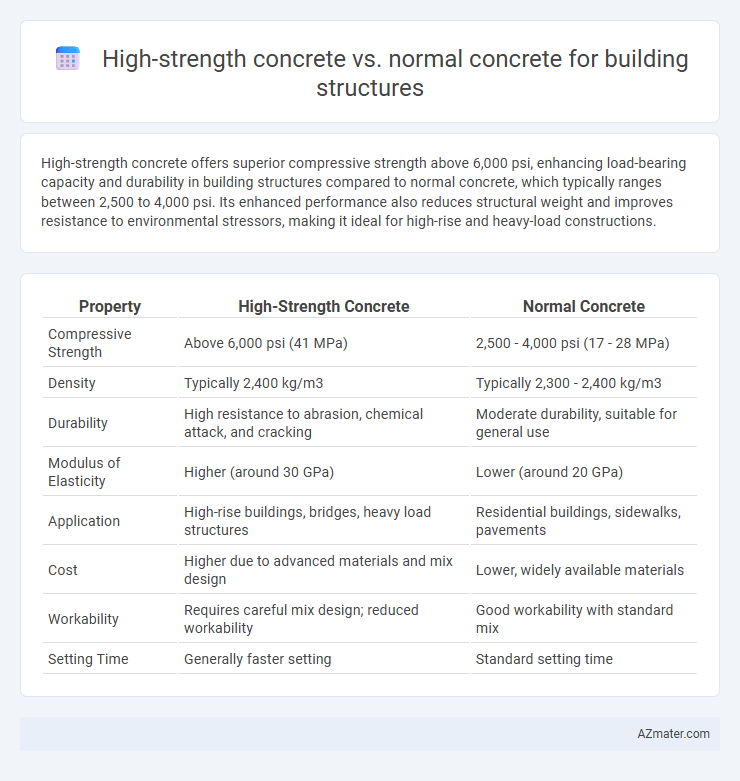High-strength concrete offers superior compressive strength above 6,000 psi, enhancing load-bearing capacity and durability in building structures compared to normal concrete, which typically ranges between 2,500 to 4,000 psi. Its enhanced performance also reduces structural weight and improves resistance to environmental stressors, making it ideal for high-rise and heavy-load constructions.
Table of Comparison
| Property | High-Strength Concrete | Normal Concrete |
|---|---|---|
| Compressive Strength | Above 6,000 psi (41 MPa) | 2,500 - 4,000 psi (17 - 28 MPa) |
| Density | Typically 2,400 kg/m3 | Typically 2,300 - 2,400 kg/m3 |
| Durability | High resistance to abrasion, chemical attack, and cracking | Moderate durability, suitable for general use |
| Modulus of Elasticity | Higher (around 30 GPa) | Lower (around 20 GPa) |
| Application | High-rise buildings, bridges, heavy load structures | Residential buildings, sidewalks, pavements |
| Cost | Higher due to advanced materials and mix design | Lower, widely available materials |
| Workability | Requires careful mix design; reduced workability | Good workability with standard mix |
| Setting Time | Generally faster setting | Standard setting time |
Introduction to High-Strength and Normal Concrete
High-strength concrete typically exceeds compressive strength of 6,000 psi, making it suitable for high-rise buildings and structures requiring superior load-bearing capacity. Normal concrete, with strengths ranging from 2,500 to 5,000 psi, is commonly used in residential and light commercial construction. The choice between high-strength and normal concrete depends on structural demands, cost, and durability requirements.
Composition Differences Between High-Strength and Normal Concrete
High-strength concrete differs from normal concrete primarily in its mix composition, featuring a lower water-to-cement ratio, higher cement content, and the inclusion of supplementary cementitious materials such as silica fume or fly ash. This optimized blend enhances compressive strength, often exceeding 6,000 psi, compared to normal concrete's typical range of 3,000 to 5,000 psi. The use of superplasticizers in high-strength concrete improves workability without increasing water content, contributing to its dense microstructure and superior durability in building structures.
Mechanical Properties Comparison
High-strength concrete (HSC) typically exhibits compressive strengths exceeding 60 MPa, significantly higher than the 20-40 MPa range of normal concrete, resulting in enhanced load-bearing capacity and reduced structural member sizes. HSC's improved mechanical properties include higher modulus of elasticity, increased tensile strength, and better durability under dynamic and fatigue loads, which contribute to longer lifespan and increased resistance to cracking. Normal concrete, while adequate for many applications, often requires larger cross-sections and reinforcement to achieve similar performance, making HSC more efficient for high-stress structural components.
Durability and Longevity Factors
High-strength concrete exhibits superior durability compared to normal concrete due to its lower porosity and increased resistance to environmental stressors such as freeze-thaw cycles, chemical attacks, and abrasion. Its enhanced compressive strength, typically exceeding 6000 psi, significantly extends the longevity of building structures by minimizing micro-cracking and reducing permeability. Choosing high-strength concrete improves structural integrity and reduces maintenance costs, making it ideal for critical infrastructure and high-load applications.
Structural Applications in Construction
High-strength concrete exhibits compressive strengths exceeding 6,000 psi, making it ideal for high-load structural applications such as high-rise buildings, bridges, and heavy-duty foundations. Normal concrete typically ranges from 2,500 to 4,000 psi and is suitable for residential buildings, pavements, and light structural elements where extreme strength is not critical. The use of high-strength concrete enhances load-bearing capacity and durability while reducing structural member size, contributing to material efficiency and architectural flexibility.
Cost Implications: Initial and Lifecycle
High-strength concrete (HSC) typically incurs higher initial costs compared to normal concrete due to the use of advanced materials and precise mixing techniques, impacting budget allocations for building structures. Over the lifecycle, HSC offers cost savings through enhanced durability, reduced maintenance expenses, and extended service life, which can offset upfront investments. Evaluating the total cost of ownership for building projects requires balancing the premium price of HSC against its long-term performance benefits and potential reductions in repair frequency.
Workability and Mixing Considerations
High-strength concrete requires precise proportioning of low water-to-cement ratios and often incorporates superplasticizers to maintain optimal workability without compromising strength. In contrast, normal concrete has higher water content, which enhances ease of mixing and placement but results in lower compressive strengths. Careful mixing techniques are essential for high-strength concrete to ensure uniform distribution of admixtures and avoid segregation, while normal concrete permits more flexible mixing practices.
Environmental Impact and Sustainability
High-strength concrete (HSC) significantly reduces the environmental footprint of building structures by requiring less material volume due to its superior load-bearing capacity, leading to lower CO2 emissions from cement production. Its enhanced durability extends the lifespan of constructions, minimizing the need for frequent repairs and resource consumption, thereby promoting sustainability. Compared to normal concrete, HSC optimizes resource efficiency and energy use, supporting eco-friendly construction practices in urban development.
Challenges in Using High-Strength Concrete
High-strength concrete offers superior compressive strength exceeding 60 MPa, making it ideal for high-rise buildings and long-span bridges, but it presents challenges such as increased brittleness and reduced ductility compared to normal concrete with strengths around 20-40 MPa. Proper mix design complexity, greater sensitivity to curing conditions, and higher costs for specialized materials like silica fume and superplasticizers complicate its use in standard construction projects. Contractors must also address potential issues with shrinkage, cracking, and difficulty in quality control to ensure structural integrity and durability when using high-strength concrete.
Choosing the Right Concrete: Key Decision Factors
High-strength concrete offers superior compressive strength, typically exceeding 6000 psi, making it ideal for high-rise buildings and structures requiring enhanced durability and reduced cross-sectional areas. Normal concrete, with strengths ranging from 3000 to 5000 psi, provides better workability and cost-efficiency for standard residential and low-rise applications. Key decision factors include load-bearing requirements, environmental exposure, project budget, and structural design specifications to ensure optimal safety and performance.

Infographic: High-strength concrete vs Normal concrete for Building structure
 azmater.com
azmater.com